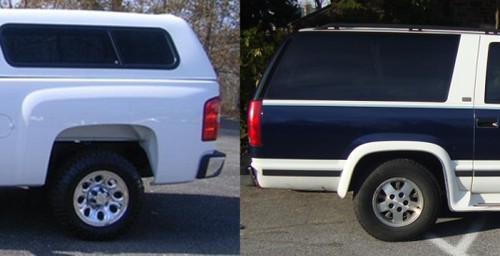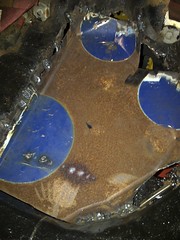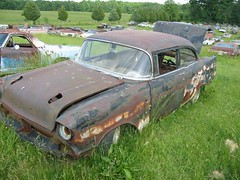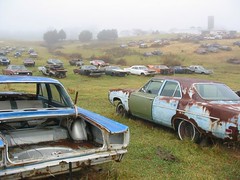It’s so sad that when my cellphone vibrates and the display
says it’s Ariel calling, a deflating sense of dread immediately overcomes me.
Nine times out of ten it’s not bad news, but ten percent of the time it’s, “my
car’s crapped out again.” The call from her Friday morning was one of those
one-out-of-tens that really ruins my day. “Daddy, my car won’t start. It’s
making that noise like the last time you had to tow him home.” Irr. It appears
the starter I rebuilt with an old Bendix drive now needs a new Bendix.
Since the truck is still not ready for towing duty, I got to
spend my lunch hour going to Harbor Freight and finally buying the 7-into- four
plug adapter so I can plug the towing lights into the Silverado’s outlet. I
also bought a couple hitches, now with a 4” drop one with a monster 6” drop.
Since I wanted the ball at the same level it was with the Suburban, I measured
the height on the Suburban before it went away, but used my worklight as the
unit of measure and I didn’t have it with me Friday, so I too the guess-work
out if and just got the two Harbor Freight had available. I tried to do a
side-by-side in Photoshop and it appears the HUGE wheel openings on the truck
make it look much taller than it really is. In other words, I thought the 4”
would be enough.

When I got home, I used my worklight and found that the
hitch I’d been using on the Suburban is less than two inches taller on the
truck than it was on the Suburban, so both hitches will go back. I was going to
get A’s car that night, but the snow, non-working towing lights, and a great
desire to get Lucy back on the road all prevented that from happening. I did
get my car done, but I was in the garage until after 1 AM. I first filled all
the seams with sealer, then installed the rear seat back, carpet, speakers, sill
plates, rear seat bottom, seat belts (after drilling new holes in the patches
for two of the belts), and, finally, the front seats. I installed the two lower
engine shrouds so Lucy’s salon will have heat and a GUP speedometer cable I'd bought from the Corvair Ranch. The last thing I did was top off
the transmission with 90 weight gear lube.
Saturday morning the lovely Loriann and I went to watch to
see Mikhaila’s cheerleading team compete. On the way we stopped at Harbor Freight,
and, after returning the hitches, I bought a connector for the towing lights
and a heat gun to shrink tubing. When I finally got home Saturday, I rewired
the lights and then Ariel, Victoria, and I headed out to drag Ringo home. Ariel
got to Ringo first, so I asked her to see if he’d start. Sure enough, my powers
are strong enough that just being within fifteen feet of the problem, I was
able to magically fix the problem. A turn of the key and he started right up. She
drove him home without issue. Then, yesterday afternoon, it started right up
for me to drive into the garage.
I’m going to replace the Bendix drive (ordered today). While
I wait for that part, there are a number of niggling problems with that car I
want to address. First, I wanted to clean up the wiring job I did when
converting Ringo to electricity maker to an alternator. A few cuts, some
soldering and shrinking tube, four zipties, and that project was completed.
Second, I wanted to fix the non-functioning gas gauge. To troubleshoot if the
sender is the problem, I made a bunch of resistance measurements at the sender’s
contacts while emptying the tank. While the first measurement (with the tank
about half full) was 14 ohms (about halfway on the 0-30 ohm designed range),
all the subsequent measurements made as the tank was being drained were 11 ohms.
I’m hoping (praying) that I just stuck the float on wrong and it’s hitting the
side of the tank preventing it from dropping all the way down. I’ll remove the
sender the next time I get out to the garage and see what resistance
measurement I get across the range of arm travel. A new sender is $55 plus
shipping, so I’m not buying a replacement unless I truly need it. Finally, I
want the engine to stop eating fanbelts. Before turning car back over to Ariel,
I’m going to replace the pulley wheels with the smoothest looking ones I can
find on my shelves. I think the pitting on one or more of the wheels is wearing
out the belts much too quickly.
This morning I'd intended to drive Lucy to work, but I knew a stop at the gas station was an immediate priority. I didn't even get to pull away from the curb, since I couldn't get the engine to fire. I think (hope) her only issues is an empty gas tank.









